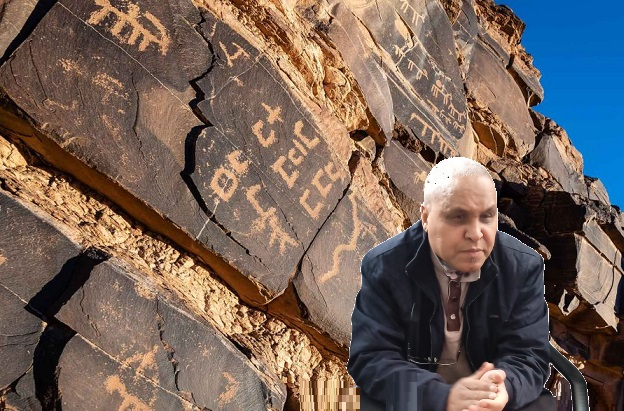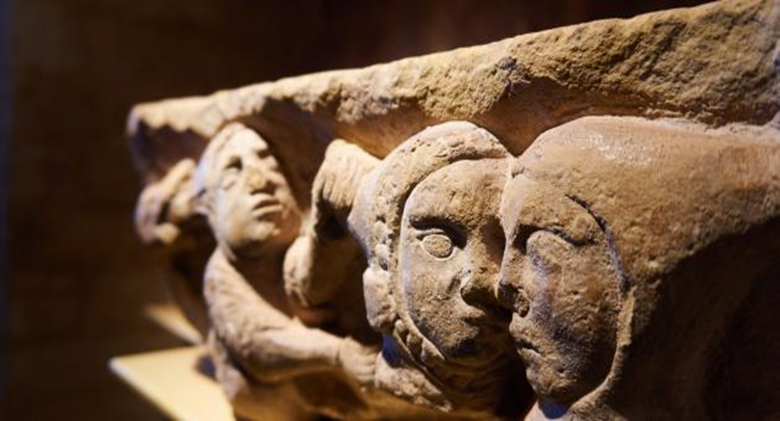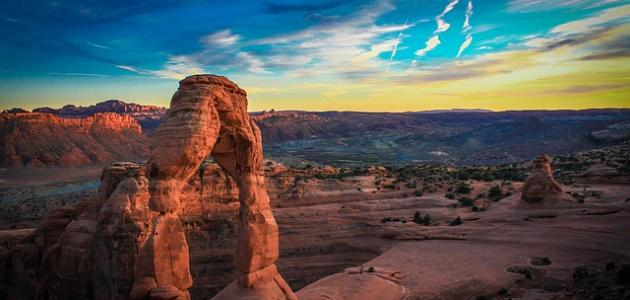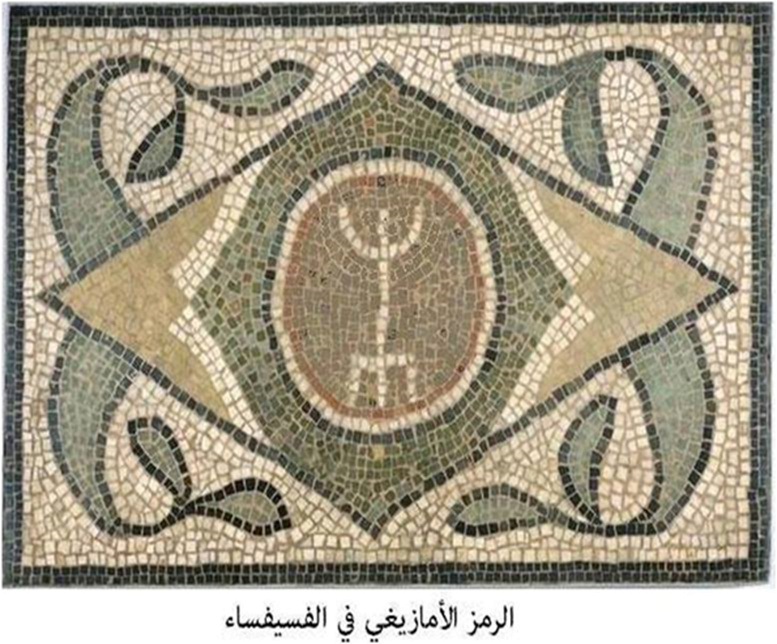The Historian's Need To Know The Amazigh Language In Order To Understand The Excavations And Read History

Within the framework of a study day, held in the city of Merirt, on Sunday, March 5, 2023, organized by the Associations of “Teachers of History and Geography” and “Tigzi Atlas for Development”, on the topic: “Local History: I Love Ossar as a Model”, and many questions that I was imagining drew my attention. A while ago, and I confirmed today in front of me without a doubt.
History as a science that studies events and facts as a work material needs openness to other sciences and arts such as sociology, anthropology, geology and other sciences. Moreover, the identity of history as a science based on criticism and analysis and seeking objectivity must have research, exploration and analysis tools. As for the fact that the nature of history is a method to reach certain scientific facts, it is an experimental and inductive method to confine the incident to be studied temporally and spatially to reach judgments that enable us to know the past and benefit from it in the present to anticipate the future.
As for the identity of history as art, we can be guided by the saying of the Sheikh of Historians, Abd al-Rahman bin Khaldun, who says in his famous introduction: “Know that the art of history is from the dear doctrine ˛ full of benefits ˛ honorable purpose…”. From this standpoint, I consider that the historian, the researcher in history, or the student of history must imbibe from a group of arts that no society is devoid of, such as poetry, anecdotes, drawing, riddles, riddles, proverbs, and others.

Following up on the professors’ interventions in the framework of their dissertations on the local history of the Ejayan region ⵉⵥⴰⵢⴰin general and White Svogo in particular, I noticed the following:
Most of the names of local utoponemia were Arabized by affixing the tied ta’a, which denotes femininity, to a group of names and flags, such as the (Ait Europe) tribe, which turned into (Europe), and the region of Waumna, whose origin is in the historical writings (Wahna ⵡⴰⵡⵀⵏⵏⴰ) and (Mreret) that was written (Mittera) in the sources The old, and the indicative angle that turned from (Ait Idila ⴰⵢⵜ ⵉⴷⴷⵉⵍⴰ ) and (Khenifra) turned into (Khenifra) and Ait Mellal ⴰⵢⵜ ⵎⵍⵍⴰⵍ ) which became (Bani Mellal) and (Taskourt ⵜⴰⵙⴽⵔ ) and many others.
Historians, history students, and research students must fully know the Amazigh language in its comprehensiveness and local variations, in order to decipher the utopianism that speaks Amazigh and refuses to forget it despite the Arabization fever.

From here, I say that the names of places, valleys, and various terrain figures in the Ijayan region, which scream at the top of their voices: – I am Amazigh. I will list some of them like:
The Umm al-Rabi` river, which turned into (Umm) + (Spring) overnight. In historical sources, it was Wanseven ⵡⴰⵏⵙⵉⴼⵏ ) . By dismantling this flag, we will find that it consists of two parts: (Win ⵡⵉⵏ / Wan ⵡⴰⵏ ) and Seven ⵙⵉⴼⵏ ) . The word Asif ⴰⵙⵉⴼ ) ) so the name is (Kabeer al-Nahr) distance, abundance and boyhood.
The second name is (Awam), which is transformed from Warkans ⵡⴰⵔⴽⵏⵏⵙ ) ) which, if we analyze this name linguistically, is composed of (War ⵡⴰⵔ ) and its feminine form (Tar ⵜⴰⵔ ) which denotes noness and non-existence, and Knos ⴽⵏⵏⵙ ) ) with an emphasis on the nun, it is from the root (K. N. S ⴽ . ⵏ . ⵙ ) ˛ We added to it the letter (a ⴰ ) at the beginning to denote the masculine, as it means (fencing in combat) . And if we go back to the area of Egrim Ossar (ⵉⵖⵔⵎ ⴰⵡⵙⵙⴰⵔ ) we will find it surrounded first by a wall, and it is an ancient city teeming with mining, manufacturing and minting coins. This makes it an economic city immune to fighting and dueling.
And if we take this wall (sweeping ⴽⵏⵙ ) then we can discern from it words in the same semantic field (Meknes) taken from the (Imknesen ⵉⵎⴽⵏⴰⵙⵏ ) Amazigh tribes known in history. And the meaning of (we could ⴰⵎⴽⵏⴰⵙ ) is that stubborn who does not give up his right no matter what it costs him. This is one of the characteristics of the Amazighs.

As for the third name, it is ( ⵉⵖⵔⵎ ⴰⵡⵙⵙⴰⵔ ). It is a blended composition consisting of ( ⵉⵖⵔⵎ ) and (Awsar ⴰⵡⵙⵙⴰⵔ ) , which are two masculine nouns because they appear respectively with (a ⵉ ) and (a ⴰ ) in the Amazigh language.
And if we go back to the wall of the word ( Egram ) , then it is ( GR.M. _
It is denoted by gram ⵉⵖⵔⵎ ) : the fort - the communal warehouse - the village - the palace. Taghrmat ⵜⵉⵖⵔⵎⵜ ) ) has its connotations: Al-Qasbah - The Little Palace - The Little Village. It also includes (Amgar ⴰⵎⵖⴰⵔ ), which means: the chief - the chief of the people - father-in-law (the father of the wife) - the sheikh of the tribe, and its feminine form is (Tamgart ⵜⴰⵎⵖⴰⵔⵜ ) . Among its meanings: the woman - the old woman and her affairs - the mother-in-law (mother of the wife). All these indications indicate highness and value as a general characteristic. It also includes (Maqour-Amqran-Tamqrant...) as well as (Tagharma), which is civilization.

The fourth term is: (Ait Idila tribe ⴰⵢⵜ ⵉⴷⴷⵉⵍⴰ ) which embraced the Dalian angle and took its name. Through the location of the zawiya and its position between the steep, rugged slopes and impregnable walls, it is possible to refer to the origin of the word (Idila ⵉⴷⴷⵉⵍⴰ ) , which is (D. L ⴷ . ⵍ ) and its meaning: embrace, cover and embrace. The thing that applies to this corner and the fortified tribe between the arms of a natural and human guard.
The fifth term is ait tawala ⴰⵢⵜ ⵜⵡⴰⵍⴰ ) if we go back to the decomposition of this additional compound ait ⴰⵢⵜ and tawala ⵜⴰⵡⴰⵍⴰ . F) (Ait) means (owner/owner) and (tawala) from its connotations: the shift and the cycle, and it also means the collective herd, and from it (Tawala n Waman ⵜⴰⵡⴰⵍⴰ ⵏ ⵡⴰⵎⴰⵏ ) i.e. the shift of water in the watering process.
Finally, it must be noted that the names of the places and the flags surrounding (Igram Ossar) all indicate the presence of water, forest, a good plow, abundant firewood, and minerals
(Tafrouamenⵜⴰⴼⵔⵡⴰⵎⴰⵏ –Almo irechkiken ⴰⵍⵎⵓ ⵉⵔⵛⴽⵉⴽⵏ –Telghmin ⵜⵉⵍⵖⵎⵉⵏ –Tighza ⵜⵉⵖⵣⴰ –Taghzout ⵜⴰⵖⵣⵓⵜ ⵓⵎⴳⴰⵀⴷ –Arif ⴰⵔⵔⵉⴼ –Boutaqqa ⴱⵓⵜⴰⵇⵇⴰ –Iker oguena ⵉⴳⵔ ⵓⴳⵏⵏⴰ –Talkhabat ⵜⴰⵍⵅⴱⴰⵜ –Tanout ⵜⴰⵏⵓⵜ –Buiqlochen ⴱⵓⵢⵇⵍⵍⵓⵛⵏ –Thona ⵜⵓⵏⴰ –Tibraouine ⵜⵉⴱⴱⵕⴰⵡⵉⵏ –Bouthazolt ⴱⵓⵜⴰⵥⵓⵍⵜ … .).

The researcher, the scholar, the interested person, and the student in history must have full knowledge of the Amazigh language in order to be able to decipher the Amazigh utopianism in different parts of the country, by relying on excavations on the ground, linguistic and linguistic excavations, and extrapolation of the various arts of Amazigh literature such as poetry, rhetoric, tales, puzzles, riddles, proverbs, and others.....
(°) A researcher in Amazigh language and literature: and a poet from his publications: Two collections of poetry in the Amazigh language and a critical study on Amazigh poetry: ( ⵢⵓⵍⵉⴷ ⵡⴰⵙⵙ – – ⴰⵏⵣⴳⵓⵎ ⵏ ⵓⵎⴰⵜⴰ Features of the Amazigh poem in the Middle Atlas)
Source : websites

